
Tai chi, short for T'ai chi ch'üan or Tàijí quán (太極拳), sometimes colloquially known as "Shadowboxing," is an internal Chinese martial art practiced for defense training, health benefits, and meditation.

The Eight Immortals are a group of legendary xian ("immortals") in Chinese mythology. Each immortal's power can be transferred to a vessel (法器) that can bestow life or destroy evil. Together, these eight vessels are called the "Covert Eight Immortals" (暗八仙). Most of them are said to have been born in the Tang or Song Dynasty. They are revered by the Taoists and are also a popular element in secular Chinese culture. They are said to live on a group of five islands in the Bohai Sea, which includes Mount Penglai.

Mantak Chia is a Taoist Master. He is best known for his teaching Taoist practices under the names of Healing Tao, Tao Yoga, Universal Healing Tao System and Qi Gong. He has run numerous workshops, written a series of books, and published a number of training videos. He views himself primarily as a teacher.
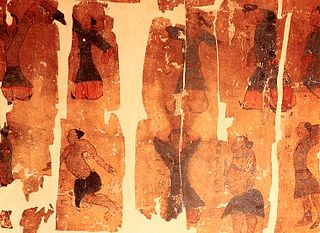
Daoyin is a series of body and mind unity exercises practiced as a form of Daoist neigong to cultivate jing (essence) and direct and refine qi, the internal energy of the body according to Traditional Chinese medicine. These exercises are often divided into yin positions, lying and sitting, and yang positions, standing and moving. The practice of daoyin was a precursor of qigong, and was practised in Chinese Taoist monasteries for health and spiritual cultivation. Daoyin is also said to be a primary formative ingredient in the well-known "soft styles" of the Chinese martial arts, of Taiji quan. and middle road styles like Wuxingheqidao.
Jīng is the Chinese word for "essence", specifically kidney essence. Along with qì and shén, it is considered one of the Three Treasures of traditional Chinese medicine or TCM.

Liuhebafaquan is an internal Chinese martial art. It has been called "Xinyi Liuhebafa" 心意六合八法拳 and is also referred to as "water boxing" due to its principles.
Dantian, dan t'ian, dan tien or tan t'ien is loosely translated as "elixir field", "sea of qi", or simply "energy center". Dantian are the "qi focus flow centers", important focal points for meditative and exercise techniques such as qigong, martial arts such as t'ai chi ch'uan, and in traditional Chinese medicine.

While there are many historical and modern schools of Taoism with different teachings on the subject, many Taoist priests regard their diet as extremely important to their physical, mental and spiritual health in one way or another, especially where the amount of qi in the food is concerned.
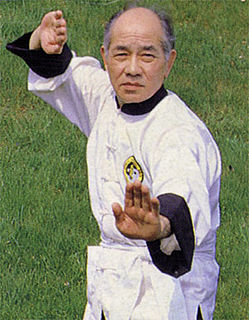
The Lee style of t'ai chi ch'uan (李氏太極拳) is closely related to a range of disciplines of Taoist Arts taught within the Lee style including Qigong, Tao Yin, Ch'ang Ming, Traditional Chinese Medicine, Taoist alchemy, Feng Shou Kung Fu, and weapons practice. According to practitioners, it was first brought to the West in the 1930s by Chan Kam Lee and was subsequently popularized by Chee Soo who was the President of the International Taoist Society from 1958 until his death in 1994. The Lee style of t'ai chi ch'uan comprises two forms known as 'the dance' or Tiào wǔ 跳舞, and 'the form'. Other exercises include Yifu Shou or 'sticky hands', Whirling Hands, Whirling Arms, and various qi and Li development exercises. Lee style t'ai chi is related to Martial Arts training, and there are five distinct areas of development that comprise the whole Art:
- Physical
- Mental
- Breathing
- Sheng Qi 生气
- Ching Sheng Li 精生力.
Neigong, also spelled nei kung, neigung, or nae gong, refers to any of a set of Chinese breathing, meditation and spiritual practice disciplines associated with Daoism and especially the Chinese martial arts. Neigong practice is normally associated with the so-called "soft style", "internal" or neijia 內家 Chinese martial arts, as opposed to the category known as waigong 外功 or "external skill" which is historically associated with shaolinquan or the so-called "hard style", "external" or wàijiā 外家 Chinese martial arts. Both have many different schools, disciplines and practices and historically there has been mutual influence between the two and distinguishing precisely between them differs from school to school.
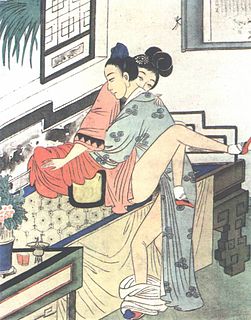
Taoist sexual practices are the ways Taoists may practice sexual activity. These practices are also known as "joining energy" or "the joining of the essences". Practitioners believe that by performing these sexual arts, one can stay in good health, and attain longevity or spiritual advancement.
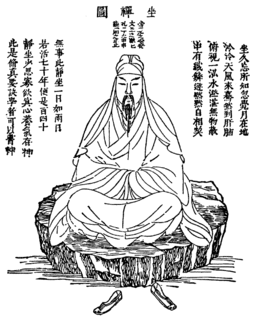
The microcosmic orbit (小周天), also known as the Self Winding Wheel of the Law, is a Taoist Qigong energy cultivation technique. It involves deep breathing exercises in conjunction with meditation and concentration techniques which develop the flow of qi along certain pathways of energy in the human body which may be familiar to those who are studying traditional Chinese medicine, Qigong, T'ai chi ch'uan, Neidan and Chinese alchemy. The exercise can be performed usually at first in a sitting position, but it can also be practiced standing as in Zhan zhuang or with movements included as with T'ai chi ch'uan.

Alex Anatole is a Taoist priest, teacher, and writer. He directs centers of Taoist studies in Russia and the United States.

Bruce Kumar Frantzis is a Taoist educator who studied Taoism in China.
Dennis Lewis is a non-fiction writer and teacher in the areas of breathing, qigong, meditation, and self-enquiry.

Chee Soo was an author of books about the philosophy of Taoism and in particular Lee-style t'ai chi ch'uan, Qigong, Ch'ang Ming, Traditional Chinese Medicine and Feng Shou 'Hand of the Wind' Kung Fu.
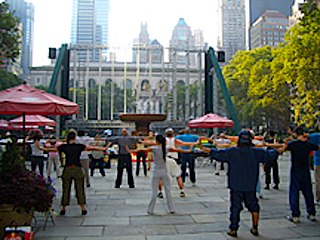
Qigong, qi gong, chi kung, chi 'ung, or chi gung is a system of coordinated body-posture and movement, breathing, and meditation used for the purposes of health, spirituality, and martial-arts training. With roots in Chinese medicine, philosophy, and martial arts, qigong is traditionally viewed by the Chinese and throughout Asia as a practice to cultivate and balance qi, translated as "life energy".
Michael Winn is an author and teacher most notable for his work with Mantak Chia. He is also known for his occult writings focused on the integration of Taoist qigong and neidan, Tao inner alchemy.

Wudang quan is a class of Chinese martial arts. The name translates as "Wudang fist." In contemporary China, Chinese martial arts styles are generally classified into two major groups: Wudang (Wutang), named after the Wudang Mountains; and Shaolin, named after the Shaolin Monastery. Whereas Shaolin includes many martial art styles, Wudangquan includes only a few arts that use the focused mind to control the waist, and therefore the body. This typically encompasses Tai ji quan, Xing-Yi chuan and Bagua zhang, but must also include Baji chuan and Wudang Sword. Although the name Wudang simply distinguishes the skills, theories and applications of the internal arts from those of the Shaolin styles, it falsely suggests these arts originated at the Wudang Mountains. The name Wudang comes from a popular Chinese legend that incorrectly purports the genesis of Tai chi chuan and Wudang Sword by an immortal, Taoist hermit named Zhang Sanfeng who lived in the monasteries of Wudang Mountain.
The history of qigong, the Chinese practice of aligning breath, movement, and awareness for exercise, healing, and martial arts training, extends back more than 4,000 years. Contemporary qigong is a complex accretion of the ancient Chinese meditative practice xing qi (行氣) or "circulating qi" and the gymnastic breathing exercise tao yin (導引) or "guiding and pulling", with roots in the I Ching and occult arts; philosophical traditions of Confucianism, Taoism, and Buddhism, traditional Chinese medicine and martial arts; along with influences of contemporary concepts of health, science, meditation, and exercise.













